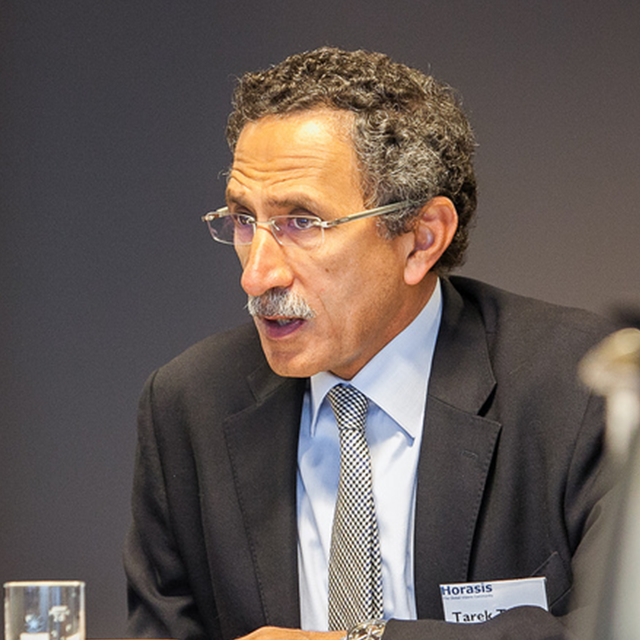Within four years, Egypt aims to substantially increase its exports to reach $100 billion, almost quadrupling its 2019 export figure of $28.5 billion. Feasible or too ambitious? We attempt to answer this question with a series of articles with key policymakers and industry leaders – this time featuring the renowned Tarek Tawfik, chairman of the Federation of Egyptian Industries (FEI), recently-elected president of American Chamber of Commerce in Egypt, and Business Forward’s editorial board member.
 Mr. Tarek Tawfik
Mr. Tarek Tawfik
Recently announced by Egypt’s Trade and Industry Minister, Neveen Gamea, the $100-billion export goal is to be achieved through a nation-wide strategy, which will include “implementing a new program aimed at boosting national industries, developing the exports of small enterprises and supporting land, sea and air freight for exports,” as reported by Arab News.
Straight off the bat, Tawfik is skeptical.
“To reach a 100 billion export goal, we need to have a clear industrial policy and strategy; both of which we’re still lacking or need them to be updated,” says Tawfik. “We need them so that we can be aware of what comparative advantages do we have, what markets are we going to be targeting, and how we’re going to achieve that goal.”
Value chains and industry clusters
A good place to start, according to Tawfik, is by getting in a value-chain mindset.
“We have to have value chains with certain dynamics that consider feeding industries; upstream all the way to downstream industries,” explains Tawfik. “We then have to calculate the value chain’s competitiveness in view of the local market and the demand size from the export market.”
For the garment industry, for example, we will need to create a value chain that considers the kind of material required, demand size, products needed in export markets; their specifications and fashion. It also needs to consider feeding industries like dye industry, printing industry, zippers industry, etc., explains Tarek, further elaborating that this systematic approach is the only way to being able to predict if Egypt can compete in one industry or another in the global market.
In addition to value chain analysis, Tawfik explains that we need to start boosting industrial clusters, as opposed to industrial zones which he opposes as a policy. Industrial clusters is when there’s a geographic concentration of firms whose trade and business activities are interconnected and complement each other, like dye and printing industries for instance.
“That’s how we can tell if these industries have economic viability as opposed to other countries that are competing with us,” elaborates Tawfik. “We could be creating a product more expensive than the [equivalent] Chinese product but that saves cost of transportation and storage [due to Egypt’s proximity to Europe], and then we find that we have an edge.”
Fundamental obstacles
In a joint study by the United Nations Industrial Development Organization (UNIDO), FEI and Egypt’s Ministry of Planning, which is yet to be made public, over 1400 export products in Egypt were analyzed, reveals Tawfik, helping pinpoint the most crucial challenges facing Egypt’s export potential. The most crucial of all, as they found out, is red tapping and bureaucracy.
“The study identified that there are $14.7 billion worth of exports in lost opportunity; products we already export to global markets but unable to realize their full [export] potential due to red-tapping. For example, an exporter imports specific packaging material that ends up at a port for two weeks [awaiting clearance]. Exporting doesn’t wait. Unless it’s cleared the same day, you lost the opportunity,” elaborates Tawfik.
It doesn’t’ stop there.
“Let’s say you want to expand your factory’s activities but can’t get land allocated; or got land allocated but can’t get electricity, gas or water. These are examples of why we can’t realize the full potential of exports,” he points out.
The average time it takes to clear goods from Egyptian ports is another crucial point that Tawfik believes needs to quickly be addressed.
“Clearance of goods takes an average of 16 days, and the container costs an average of $1000 to clear,” explains Tawfik. While in OECD countries, clearance takes three and a half hours and costs $30 per container. Why would investors come here then? When it comes to exports, it’s either you’re there on time, or you’re out.”
There had been talks for years on the Egyptian government’s digitization of bureaucratic procedures to increase efficiency and cut waiting time for investors and citizens alike. Could that be a step in the right direction?
“There’s a difference between digitization and digital transformation,” exclaims Tawfik, “If I digitize a dysfunctional system, it will remain dysfunctional; what we need to do is cut the red tape, streamline the operation and then digitize, only then it will flow.”
“We studied each sector which the Ministry of Finance say the clearance for has been reduced from six days to five days, and found out that this is wrong because they took an average. We took it by product and by port and found that the clearance time had actually multiplied.”
What looks promising?
With the government’s administrative reform program being in full swing for a few years now, Egypt has already taken major leaps in boosting different industries and trade, particularly in agriculture and mining.
“Availing land and water facilities to rent and acquire will have a dramatic impact on food manufacturing and export,” explains Tawfik. “Because when we open new areas for agriculture, the backbone of our food sector is slowly becoming the new desert farms that we’re creating, not the old delta. And in the new projects, there’s emphasis on subsistence agriculture; unlike the old delta which is mostly about collective farming, making it more haphazard and lacking clear traceability or food safety.”
“In the newer farms established outside the delta, farming happens in clean environments and products are traceable and mechanized, so they can be scaled up and built on. Egypt is working well in this direction, and this will accelerate food manufacturing and exports.”
The recently established National Food Safety Authority is another export-boosting step, believes Tawfik, as it creates an accountable entity for the food products of Egypt, enabling them to enter new markets where food safety regulations are strict.
Another important regulatory step was the issuing of the mining law in Egypt, opening up the sector to multinational investors – potentially replicating the success story of the oil and gas sector in Egypt.
“There have been concessions recently obtained by multinational companies to exploit the untapped minerals of Egypt, particularly in the Eastern Desert,” explains Tawfik. “This is going to be a windfall of investments, extraction and exports, even downstream value addition, and will be an accelerator for FDI and attracting investors.”
Takeaways
In short, Egypt has successfully moved forward in many directions to make achieving the $100 billion export goal a reality, albeit also falling short in some of its efforts. To ensure realization of that goal, Tawfik sums up his recommendations:
“We need a clear industrial policy and targeted approach in what industries we need to focus on, based purely on value chain analysis. We need to forget about the concept of industrial zones and start thinking about industrial clusters that can attract investments from a lot of small feeding industries [SMEs], the backbone of any economy. We’re not yet attracting those; it’s mostly the big guns that we’re attracting so far.”
Furthermore, Tawfik stressed on accelerating efforts in three directions: easing traffic across borders, availing the process of allocating land and resources to investors so that it’s based on merit and clearly identified industry clusters that Egypt aims to boost.
“Third is we have to completely reform the industrial development authority because it’s totally defunct. This is an area that requires restructuring of the agency in order to be able to apply the law,” adds Tawfik.
A further important consideration when it comes to structural changes is establishing clear coordination between all cabinet ministries through a central command. We have to all be on the same page with one KPI; not a different KPI for each ministry,” concludes Tawfik.
Stay tuned for more articles in our exclusive series: What will it take for Egypt to reach the $100 billion export goal?









